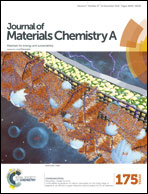Core–shell rGO/SnO2@CF with wrinkled surface used as structural anode material: high tensile strength and electrochemical stability
Abstract
As one of the most promising structural anode materials, carbon fibers (CF) have gained much attention. One of the central problems in their application is retaining their tensile strength and simultaneously improving their electrochemical properties. Herein, we report reduced graphene oxide/SnO2@carbon fibers (rGO/SnO2@CF) with wrinkled surfaces, fabricated via a simple hydrothermal method followed by heat treatment. This material exhibits prominent tensile properties, improved reversible capacity, excellent cycling stability and significantly enhanced first cycle coulombic efficiency. Compared to the reversible capacity at the 20th cycle, the rGO/SnO2@CF retained 93.6% reversible capacity after 100 cycles at 50 mA g−1, corresponding to a capacity fading of only 0.08% per cycle. The Weibull scale parameter and shape parameter of rGO/SnO2@CF were up to 4.63 GPa and 7.87, respectively. Our measurements revealed that the positive influence of rGO effectively countervailed the negative influence of the hydrothermal process on the tensile strength; the interleaved structure of rGO/SnO2 prevented the dispersion degree of tensile strength from decreasing; the synergistic effect of rGO and SnO2 enhanced the properties of the carbon fibers, including the tensile strength and the electrochemical properties; the formed rGO network structure and bicontinuous electronic transport pathway are in favor of the cycling stability.


 Please wait while we load your content...
Please wait while we load your content...